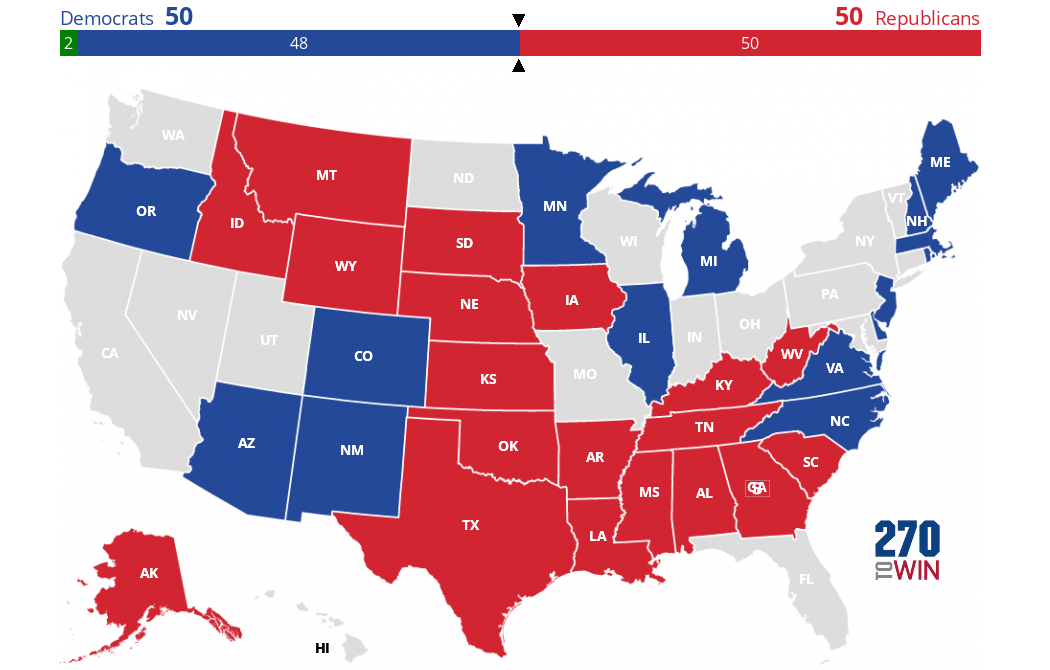
Tuesday, January 5 will see the final election of the 2020 election season take place: the runoff votes for the United States Senate elections in Georgia. The state of Georgia saw elections take place in both of its US Senate seats: the regular cycle election for the Class II seat currently held by David Perdue, and a special election for the Class III seat currently held by Kelly Loeffler.
Georgia operates a runoff system in its elections: if no candidate receives 50% of the vote in an election, then the top two candidates will advance to a runoff election, as was the case in both Senate races. In addition, Georgia state law dictates that special elections are conducted as non-partisan blanket primaries, meaning that multiple candidates from the same party compete against each other to advance to the runoff.
In Tuesday’s special election, Loeffler, the Republican incumbent who was appointed by Governor Brian Kemp on January 6, 2020 following Senator Johnny Isaakson’s resignation, saw off a strong challenge from Congressman Doug Collins for a spot in the runoff. Loeffler will face Democrat Rev. Raphael Warnock in Tuesday’s runoff; Warnock topped the blanket poll in November with 32.9% of the vote to Loeffler’s 25.9% and Collins’s 20.0%.
Perdue, meanwhile, will face Democrat Jon Ossoff in the regular cycle election, both candidates having been denied a majority of votes by the Libertarian candidate. Perdue is seeking a second term in the Senate, whereas this is the second special election in the state of Georgia that Ossoff is contesting: he was the Democratic candidate in the 2017 special election in Georgia’s 6th Congressional District, losing the runoff to Republican Karen Handel.
Georgia’s role in the 2020 Presidential Election has been both noteworthy and notorious: Joe Biden’s victory here in November’s Presidential Election – the first for a Democrat since 1992 – by just 12,000 votes helped secure him enough Electoral College votes to deny Donald Trump a second term. However, it has also been home to electoral controversy never before seen as part of the President’s campaign against the election results, most recently when President Trump pressured Georgia Secretary of State Brad Raffensperger to “find” additional votes for him.
With Joe Biden’s victory in the Presidential Election, the Georgia Senate runoff elections are crucial for both parties: following November’s elections, the Senate Republicans lost two seats (Arizona and Colorado) and gained another (Alabama), giving the party 50 seats in the Senate at this time. If the Democrats can win both of these Senate seats, then the Senate will be tied (two Independent Senators caucus with the Democrats). In the event of a tied Senate vote, it falls to the Vice President to cast the deciding vote; on January 20th, the Vice President will be Kamala Harris. So while Mitch McConnell will remain the Senate Majority Leader, a loss of the two Senate seats in Georgia could effectively mean loss of control of the Senate for the Republicans. Even if the Republicans can hold just one of the Senate seats in Georgia, then holding 51 seats in the Senate may just be enough to provide McConnell with some breathing space.
So what are the polls saying? According to FiveThirtyEight’s running tally of polls from a variety of providers – some more reliable than others – gives Ossoff an average lead of 1.4 points and Warnock an average lead of 2.0 points as of January 4. This means that both races are effectively too close to call. However, the Democrats cannot afford to be complacent; there is usually some pro-incumbent unwind in particularly close elections, and the Democrats are still recovering from other Senate losses in races which they were thought to have locked in, including in Maine and North Carolina.
However, with Biden’s victory here in the Presidential Election, and significant attention being paid to Georgia’s possible new-found status as a purple state, if nothing else it would be a significant achievement for the Democrats to flip the state from a Republican trifecta with two Republican Senators and a six-Presidential Election victory streak to a Democrat state with two Democrat senators. That would be significant in itself, and may signal Georgia as a beacon in a new generation of swing states.
However, it will remain to be seen how the unique and controversial characteristics of this particular election cycle will impact the runoff votes. Are the attacks on the election results by the President and his closest supporters going to turn more reasonably-minded Republicans away from these elections, or is it going to shore up Perdue and Loeffler’s support even more? And with the Democrats back in control of the White House, will every Democrat who voted in November feel the need to turn out for Tuesday’s elections? More than three million early votes have already been cast in the runoffs, although – as with the increased turnout in November’s elections – this may not be as much assistance to the Democrats as previously thought.
Tuesday’s Senate runoffs in Georgia will draw a close to one of the most controversial and divisive election cycles of our time. On January 6, Congress will validate November’s Electoral College vote, although this has also seen a challenge from Trump’s supporters. The results of the runoff may provide short-term relief for the winning party, but with a tight Senate margin, a contested Presidential Election, and the Democrats barely maintaining control of the House of Representatives – along with reflection by both parties on where they go from here – the first two years of Biden’s presidency may well be a difficult time for both parties.

